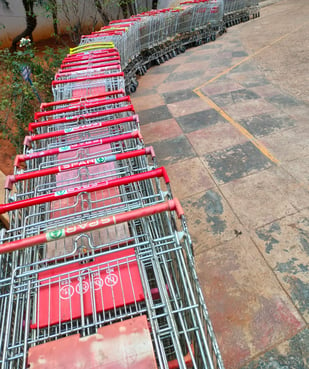Trolley Mismanagement- Spar supermarket
Read how SPAR supermarket can use behavioural science to solve its trolley loss problem.
CASE STUDIES
Sukhada Annigeri
1/19/20253 min read


The Problem
SPAR Supermarket, located in Mantri Mall, Bengaluru, faces a persistent logistical challenge: shoppers residing in the apartment next door frequently take supermarket trolleys to their apartment complex, leaving them in the vicinity rather than returning them. This issue causes several operational setbacks:
Reduced Trolley Availability: With a significant number of trolleys missing, SPAR faces shortages during peak hours, particularly on weekends and holidays.
Increased Labour Costs: Manpower is allocated to retrieve trolleys twice a week, diverting staff from other duties and increasing operational costs.
Damage and Maintenance Costs: Frequent use of trolleys on rough surfaces outside the mall accelerates wear and tear, increasing repair costs and shortening the trolley lifespan. Each trolley replacement costs 6,700 INR.
Analysis Through the COM-B Model
Using the COM-B model, we identified that Motivation was the primary barrier, with Opportunity playing a secondary role. Residents lack both the immediate incentive to return trolleys and social reinforcement for responsible behaviour.
Insights
Awareness and Accessibility: While specific bays in the basement of the apartment complex are designated for trolley return, many residents are unaware of their existence.
Social Norm Influence: The prevalent behaviour is to leave trolleys near the apartment entrances. This lack of adherence to the trolley return system discourages even willing residents from following through.
The Solution
To address this, a two-pronged intervention was designed to modify shopper behaviour using nudges and incentives.
1. Discouraging Trolley Use Beyond the Mall
This strategy aims to reduce the initial incentive to take trolleys into the apartment complex, dealing with the problem at its source.
Enhanced Home Delivery Service: By partnering with local delivery services (e.g., Dunzo), SPAR could offer real-time, affordable home delivery directly to the residents of the apartments. Alternatively, dedicated delivery staff could facilitate prompt delivery for nearby residents, removing the need for trolleys.
Point Accumulation System: This points-based loyalty program encourages shoppers to leave trolleys at the supermarket:
Default Option: Customers are prompted at checkout to leave their trolley behind, earning additional reward points in return.
Additional Points Incentive: Points are added to a shopper’s account for each instance they leave their trolley at the store, reinforcing trolley-return behaviour and encouraging others to follow suit.
2. Incentivizing Trolley Return to Designated Bays
When trolleys are still taken to the apartment complex, this second intervention focuses on encouraging responsible return to the designated bays.
Stamp Card Reward Program: Each shopper who returns their trolley to the designated bay receives a stamp on a reward card. After 10 stamps, shoppers can redeem rewards such as grocery discounts. This tangible reward system encourages habitual compliance, reinforcing trolley returns while creating a social expectation of responsible behaviour among residents.
Results and Key Takeaways
These solutions target both individual motivation and social norms, creating a behaviorally informed framework that, if implemented, can reduce operational strain on SPAR and enhance resident convenience.
Reduced Trolley Loss: Enhanced delivery options and incentivized points have the potential to reduce trolley usage outside the supermarket significantly.
Improved Return Compliance: The stamp card program promotes social norms around responsible trolley return, achieving higher compliance rates.
Cost Savings: Reduced repair needs and labour reallocation translate into notable cost savings for SPAR
Conclusion
By leveraging behavioural insights through the COM-B model, we can effectively address a logistical issue with a solution that combines convenience, rewards, and social influence. This intervention illustrates how minor behaviour shifts, incentivized through strategic nudges, can transform operational challenges into opportunities for efficiency.








